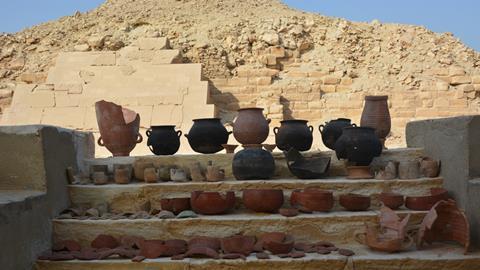To preserve their mummies, the ancient Egyptians imported resins from Southeast Asia. An early example of globalisation, argue German and Egyptian researchers in Nature.
They base their argument on a workshop from the 26th dynasty, around 600 BC, rediscovered in 2016 in the necropolis of Sakkara. There were more than a hundred jars and bowls, some intact, with inscriptions indicating the name of the contents and their role in the embalming process of the time. Think of mixtures ‘for the head’, ‘for the wrapping’ or ‘for a pleasant smell’.
Such finds are no longer allowed to leave Egypt, but Maxime Rageot, Philipp Stockhammer and colleagues from Tübingen and Munich managed to arrange a collaboration with a laboratory in Cairo that has the equipment and expertise to analyse residues in pottery using gas chromatography and mass spectrometry. The focus was on terpenoids, organic compounds whose molecular structure is often so specific to a particular plant species that their origin can be determined with a high degree of certainty.
Triterpenes
Many of these terpenoids are bactericidal and fungicidal. This was essential for the ancient Egyptians in their efforts to preserve the remains of their dead for as long as possible, says Daniel Soliman, an Egyptologist at the National Museum of Antiquities in Leiden. “They believed that the soul could only travel back and forth from the afterlife to the world of the living through the body. Certain raw materials, such as beeswax and sweet-smelling resins, also had a religious function: to transform the body so that it could live among the gods.’
Embalming was therefore the work of priests who were paid for it. Analysis of 31 pieces of pottery now suggests that they provided value for money. The researchers were particularly surprised by the presence of lupeol and α- and β-11-ketoamyrins, a combination of triterpenes known to occur only in the resin of Canarium trees. This type of resin is known as elemi and has long been associated with mummies.
Trade networks
It was previously thought that the Egyptians extracted it from local tree species, but Canarium only grows in tropical rainforests, including in central Africa and south-east Asia. The latter origin is the most obvious, especially as traces of damar resin, which is actually only found there, have also been found. Soliman knew that trade networks with Asia existed in ancient times, but that they extended as far as this was new. He agrees with the authors that the Egyptians would not have gone to get the resins themselves, but that the exports must have gone through a series of middlemen.
Of course, resins and essential oils were also found from plants that grow along the Mediterranean coast, such as pistacia, cypress and juniper, as well as cedar from Lebanon and the surrounding area. Animal fats (mainly from ruminants), tar, bitumen and beeswax completed the raw material mix. Interestingly, bowls labelled ‘antiu’ were also found to contain such ingredients; previously antiu had been translated as ‘myrrh’ or ‘frankincense’, but these aromatic substances were not present in detectable quantities.
Standard tools
Hans-Gerd Janssen, Unilever’s expert in natural product analysis, calls it ‛a nice application of modern methods, but from an analytical point of view, nothing more’. In his field, GC-MS is standard equipment. However, as far as he can judge, the analyses were carried out thoroughly and he does not believe that other methods or additional techniques would have provided much additional information.
It is unfortunate, however, that the analyses are qualitative and do not provide any insight into the mixing ratios. Why the Egyptians chose these combinations is even more curious. Centuries of experimentation must have produced a wealth of knowledge about chemical and biological properties. Some jars show traces of a fire having been lit underneath them, so they must have been able to make things react. But why was oriental elemi worth the extra cost, unless there was a religious motive behind it? Experimenting with these resins again seems to be the only answer. In fact, the authors hope that it will provide knowledge that can benefit modern medicine.
Maxime Rageot, et al., Biomolecular analyses enable new insights into ancient Egyptian embalming, Nature (2023)













Nog geen opmerkingen